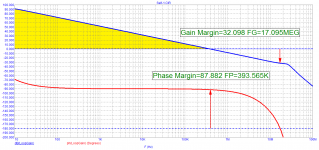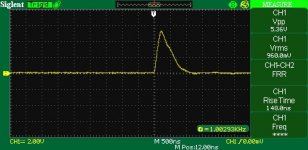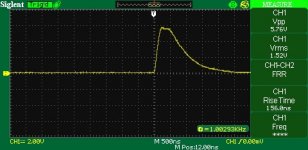More than 50 years ago, Baksandall investigated the slew rate of real signals at the output of amplifiers and did not find it higher than 0.5 V / μs. According to fagos, amplifiers with SR = 1 V / μs must fully meet the high quality amplification requirements. Fagos, the TDA2030 fully meets your requirements with a tenfold margin.
And what about in practice?
SR = 1V/uS for output voltage 1V peak. If your amplifier have output 100V peak, you need 100V/uS.
It seem, you do not understand about SR and very limited knowledge about amplifier design.
I suggest to you to learn about basic electronic first, than you can discuss about amplifier design. At least try to design amplifier with 35 VDC symmetric power supply and slew rate about 100V/uS. Do not copy other design, so you can learn how to design an amplifier. For experts in this forum, this is very easy.
petr_2009, you need to make up your mind. If Peter Baxandall convincingly proved that a certain slew rate is sufficient, why then believe marketing slogans from JC and others?
Either you are on the engineering side or on the marketing side. Otherwise you keep going around in circles and never get anywhere.
Jan
Either you are on the engineering side or on the marketing side. Otherwise you keep going around in circles and never get anywhere.
Jan
Today, every self-respecting audio engineer begins designing an audio amplifier by debugging a circuit in a simulator. What is the point of building a printed circuit board for a circuit from which it is impossible to obtain the parameters necessary for today. “Yesterday AMP” with good parameters in the steady-state mode, but with “dead” sound, nobody needs today.Enjoy your simulated amps.
Those who are not friends with the simulator, but rely only on chance, can only sympathize
I really hope that everyone who really understands development, unlike bimo, has found useful information for himself.
Last edited:
Those who are not friends with electronic design, but rely only on chance, can only sympathize
I really hope that everyone who really understands development, unlike petrxyz, has found useful information for himself.
I really hope that everyone who really understands development, unlike petrxyz, has found useful information for himself.
John Curl, the promoter ob Bybees, seriously_?😛So John Curl, who you quoted is a designer of 'yesterday amps'?
petr, you keep mentioning the improvement in sound but you haven't described it or why it might be.
Jan, regarding advertising. Many well-known companies became disillusioned with the infallibility of NFB and began to develop amplifiers without it: a range of LAMM amplifiers; Denon PMA-700, PMA-757, POA-2200, POA-3000, POA-6600; Pioneer A-09 !, Nakamichi PA5, PA7, TA2; Tandberg TPA-3006, TPA-3026; Sony TA-N902; Akai AM-A90 and many others. Graham failed to convince you, and I'm not going to do it. You don’t want to see beyond your nose and don’t need to.petr_2009, you need to make up your mind. If Peter Baxandall convincingly proved that a certain slew rate is sufficient, why then believe marketing slogans from JC and others?
Either you are on the engineering side or on the marketing side. Otherwise you keep going around in circles and never get anywhere.
Jan
bimo, following your logic, the output voltage of operational amplifiers with a power supply of + -15 V and SR = 1000V / us should be at least 1200 V from peak to peak, since they are measured at 80 ... 90% of the total amplitude. You can immediately see how you understand, and in the same place - you undertake to teach others.
You really have no clue how this industry works, do you? Companies start with no-feedback designs for two reasons: one, to a have a marketing advantage to be able to distinct them selves from the competition, second when lots of consumers that do not understand design could be convinced that feedback sounds bad. That's how it works. Same with directional cables, expensive gold foil caps, audio internet routers.
Jan
Jan
So John Curl, who you quoted is a designer of 'yesterday amps'?
Most probably yes.
//
That backfired 😉
Oh it worked as I intended. I thought the irony was delicious.That backfired 😉
Enjoy your simulated amps.
Today, every self-respecting audio engineer begins designing an audio amplifier by debugging a circuit in a simulator. What is the point of building a printed circuit board for a circuit from which it is impossible to obtain the parameters necessary for today. “Yesterday AMP” with good parameters in the steady-state mode, but with “dead” sound, nobody needs today.
Those who are not friends with the simulator, but rely only on chance, can only sympathize
I really hope that everyone who really understands development, unlike bimo, has found useful information for himself.
Well petr_2009, it seems you have found yourself as well a delusional comfort zone in SimCity which you apparently are afraid to crawl out of despite having been requested a few times by me and others to show us a real amplifier of yours with pictures, measurements and real world explanations.
I already asked couple of times, Here and Here, which you pretended you didn't see, so when will we see any real data from you beyond endless simulations and anecdotes about other peoples amplifiers... or are you afraid it will hurt too much when your little sim bubble bursts? 😛
First, stop fantasizing. I did not write any calculations on the sufficiency of the slew rate, I do not need to attribute my speculations. You'd better take it yourself and, from an engineering point of view, substantiate the figure 100 V/us, and not refer to John Сurl.More than 50 years ago, Baksandall investigated the slew rate of real signals at the output of amplifiers and did not find it higher than 0.5 V / μs. According to fagos, amplifiers with SR = 1 V / μs must fully meet the high quality amplification requirements. Fagos, the TDA2030 fully meets your requirements with a tenfold margin
In the post you quoted, JC kind of hints to you that there is no point in chasing sky-high slew rates. You can - well, no - that's enough. No one here denies that the slew rate should be appropriate for the task at hand, but you are fixated on it and don't want to see anything else.
The most indicative would be a variant with the same amplifier bandwidth, but one with a low pole and a greater NFB depth at low frequencies, and the second with a high pole and the same NFB depth throughout the entire range to the pole. And your options differ in both NFB depth and bandwidth. In total, your experiment is not indicative and contains too many influencing factors that you simply ignore, because they do not fit into your mainstream of conclusions.Another important difference between axleless amplifiers is the behavior of the output impedance; they react to external influences instantly - without a phase shift, which is inevitable in amplifiers with NFB having the first pole below 200 kHz (AMP Hiraga)
Graham also paid attention to the behavior of the output resistance (impedance).
All other things being equal, amplifiers with lower signal propagation delay sound better. This has been confirmed by numerous colleagues who have asked me for help in finalizing their amplifiers.
This is how you summarized and all at once practically praised everyone as illiterate, did I understand correctly? At the same time, they themselves modestly kept silent and did not show any real measurements made by you after three times questions about it. And how can you have a constructive dialogue and competent technical dispute? You take everything as a personal insult, while you do not consider the opinions of others and openly insult them.I just tried to show on the simulation results what Graham claimed, but he never found understanding. On this I bow, everyone can remain with their delusions. Continue making amplifiers without paying attention to Group Delay, only then don't be surprised that your creation does not sound the best. Although for mp3 with 128 bitrate will do.
Seeming sound sources tell you about anything? (when the musicians are localized on the stage and become tangible), the depth of the stage, microdynamics (after-sound, etc.), the transparency of the sound. Anyone who understands sound will immediately feel the difference ...petr, you keep mentioning the improvement in sound but you haven't described it or why it might be.
How do the examples I give do not meet your requirements? If mine doesn't suit you - bring yours and prove otherwiseThe most indicative would be a variant with the same amplifier bandwidth, but one with a low pole and a greater NFB depth at low frequencies, and the second with a high pole and the same NFB depth throughout the entire range to the pole.
or do you not understand what you are talking about? writing to show off?
Attachments
Last edited:
unlike the talkers, I do specific things. Here is the result of checking one of the amplifierswhich you pretended you didn't see, so when will we see any real data from you beyond endless simulations and anecdotes about other peoples amplifiers... or are you afraid it will hurt too much when your little sim bubble bursts? 😛
Attachments
Those sound like timing issues and yet the system is already bandwidth limited, what is your explanation for the perceived differences?Seeming sound sources tell you about anything? (when the musicians are localized on the stage and become tangible), the depth of the stage, microdynamics (after-sound, etc.), the transparency of the sound. Anyone who understands sound will immediately feel the difference ...
Timing issues, or reduced non-stationary low-level noise and distortion because of less disturbance of amplifier linearity/stationarity by the same old environmental RF incursion that's always there?
Also, please consider that a standard audio FFT is not necessarily a very accurate way to measure such effects.
Also, please consider that a standard audio FFT is not necessarily a very accurate way to measure such effects.
Last edited:
- Home
- Amplifiers
- Solid State
- First cycle distortion - Graham, what is that?




